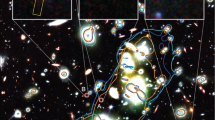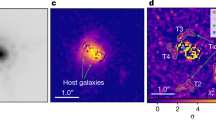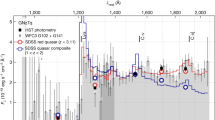Abstract
The detection of starlight from the host galaxies of quasars during the reionization epoch (z > 6) has been elusive, even with deep Hubble Space Telescope observations1,2. The current highest redshift quasar host detected3, at z = 4.5, required the magnifying effect of a foreground lensing galaxy. Low-luminosity quasars4,5,6 from the Hyper Suprime-Cam Subaru Strategic Program (HSC-SSP)7 mitigate the challenge of detecting their underlying, previously undetected host galaxies. Here we report rest-frame optical images and spectroscopy of two HSC-SSP quasars at z > 6 with the JWST. Using near-infrared camera imaging at 3.6 and 1.5 μm and subtracting the light from the unresolved quasars, we find that the host galaxies are massive (stellar masses of 13 × and 3.4 × 1010 M☉, respectively), compact and disc-like. Near-infrared spectroscopy at medium resolution shows stellar absorption lines in the more massive quasar, confirming the detection of the host. Velocity-broadened gas in the vicinity of these quasars enables measurements of their black hole masses (1.4 × 109 and 2.0 × 108 M☉, respectively). Their location in the black hole mass–stellar mass plane is consistent with the distribution at low redshift, suggesting that the relation between black holes and their host galaxies was already in place less than a billion years after the Big Bang.
This is a preview of subscription content, access via your institution
Access options
Access Nature and 54 other Nature Portfolio journals
Get Nature+, our best-value online-access subscription
$29.99 / 30 days
cancel any time
Subscribe to this journal
Receive 51 print issues and online access
$199.00 per year
only $3.90 per issue
Buy this article
- Purchase on Springer Link
- Instant access to full article PDF
Prices may be subject to local taxes which are calculated during checkout




Similar content being viewed by others
Data availability
The JWST data are available in the MAST and can be accessed through https://archive.stsci.edu/doi/resolve/resolve.html?doi=10.17909/2z59-3v32 (JWST GO 1967) after a 12-month exclusive access period. Reduced quasar NIRCam image cut-outs are also available from the corresponding author upon request or at https://github.com/dartoon/publication/tree/main/SHELLQs_J2236_J2255_data.
Code availability
The JWST data were processed with the JWST calibration pipeline (https://jwst-pipeline.readthedocs.io). Public tools were used for data analysis: galight12, galfit35 and PyQSOFit42.
References
Mechtley, M. et al. Near-infrared imaging of a z = 6.42 quasar host galaxy with the Hubble Space Telescope Wide Field Camera 3. Astrophys. J. 756, L38 (2012).
Marshall, M. A. et al. Limits to rest-frame ultraviolet emission from far-infrared-luminous z ~ 6 quasar hosts. Astrophys. J. 900, 21 (2020).
Peng, C. Y. et al. Probing the coevolution of supermassive black holes and galaxies using gravitationally lensed hosts. Astrophys. J. 649, 616–634 (2006).
Matsuoka, Y. et al. Subaru high-z exploration of low-luminosity quasars (SHELLQs). I. Discovery of 15 quasars and bright galaxies at 5.7 < z < 6.9. Astrophys. J. 828, 26 (2016).
Matsuoka, Y. et al. Subaru high-z exploration of low-luminosity quasars (SHELLQs). IV. Discovery of 41 quasars and luminous galaxies at 5.7 ≤ z ≤ 6.9. Astrophys. J. Suppl. Ser. 237, 5 (2018).
Matsuoka, Y. et al. Subaru high-z exploration of low-luminosity quasars (SHELLQs). XVI. 69 new quasars at 5.8 ≤ z ≤ 7.0. Astrophys. J. Suppl. Ser. 259, 18 (2022).
Aihara, H. et al. The Hyper Suprime-Cam SSP survey: overview and survey design. Publ. Astron. Soc. Jpn 70, S4 (2018).
Fan, X. et al. A survey of z > 5.8 quasars in the Sloan digital sky survey. I. Discovery of three new quasars and the spatial density of luminous quasars at z ~ 6. Astrophys. J. 122, 2833–2849 (2001).
Bañados, E. et al. An 800-million-solar-mass black hole in a significantly neutral Universe at a redshift of 7.5. Nature 553, 473–476 (2018).
Fan, X., Banados, E. & Simcoe, R. A. Quasars and the intergalactic medium at cosmic dawn. Preprint at https://arxiv.org/abs/2212.06907 (2022).
Rieke, M. J., Kelly, D. & Horner, S. Overview of James Webb Space Telescope and NIRCam’s role. In Proc. SPIE 5904, 1–8 (2005).
Ding, X. et al. The mass relations between supermassive black holes and their host galaxies at 1 < z < 2 HST-WFC3. Astrophys. J. 888, 37 (2020).
Sérsic, J. L. Boletin de la Asociacion Argentina de Astronomia. La Plata Argentina 6, 41–43 (1963).
Jakobsen, P. et al. The Near-Infrared Spectrograph (NIRSpec) on the James Webb Space Telescope. I. Overview of the instrument and its capabilities. Astron. Astrophys. 661, A80 (2022).
Grazian, A. et al. The galaxy stellar mass function at 3.5 ≤ z ≤ 7.5 in the CANDELS/UDS, GOODS-South, and HUDF fields. Astron. Astrophys. 575, A96 (2015).
Vestergaard, M. & Peterson, B. M. Determining central black hole masses in distant active galaxies and quasars. II. Improved optical and UV scaling relationships. Astrophys. J. 641, 689–709 (2006).
Li, J. et al. On the connection between supermassive black holes and galaxy growth in the Reionization Epoch. Astrophys. J. Lett. 931, L11 (2022).
Kormendy, J. & Ho, L. C. Coevolution (or not) of supermassive black holes and host galaxies. Annu. Rev. Astron. Astrophys. 51, 511–653 (2013).
Habouzit, M. et al. Co-evolution of massive black holes and their host galaxies at high redshift: discrepancies from six cosmological simulations and the key role of JWST. Mon. Not. R. Astron. Soc. 511, 3751–3767 (2022).
Inayoshi, K. et al. Rapid growth of seed black holes during early bulge formation. Astrophys. J. 927, 237 (2022).
Häring, N. & Rix, H.-W. On the black hole mass-bulge mass relation. Astrophys. J. Lett. 604, L89–L92 (2004).
Bennert, V. N., Auger, M. W., Treu, T., Woo, J.-H. & Malkan, M. A. A local baseline of the black hole mass scaling relations for active galaxies. I. Methodology and results of pilot study. Astrophys. J. 726, 59 (2011).
Matsuoka, Y. et al. Subaru high-z exploration of low-luminosity quasars (SHELLQs). V. Quasar luminosity function and contribution to cosmic reionization at z = 6. Astrophys. J. 869, 150 (2018).
Bradley, L. et al. astropy/photutils 1.4.0. Zenodo https://zenodo.org/record/6385735 (2022).
Jahnke, K. et al. Ultraviolet light from young stars in GEMS Quasar host galaxies at 1.8 < z < 2.75. Astrophys. J. 614, 568–585 (2004).
Mechtley, M. et al. Do the most massive black holes at z = 2 grow via major mergers?. Astrophys. J. 830, 156 (2016).
Marian, V. et al. Major mergers are not the dominant trigger for high-accretion AGNs at z ~ 2. Astrophys. J. 882, 141 (2019).
Glikman, E. et al. Major mergers host the most-luminous red quasars at z ~ 2: a Hubble Space Telescope WFC3/IR study. Astrophys. J. 806, 218 (2015).
Chen, Y.-C. et al. A close quasar pair in a disk-disk galaxy merger at z = 2.17. Nature 616, 45–49 (2023).
Dong, X. Y. & Wu, X.-B. Herschel observed Stripe 82 quasars and their host galaxies: connections between AGN activity and host galaxy star formation. Astrophys. J. 824, 70 (2016).
Ding, X., Silverman, J. D. & Onoue, M. Opening the era of quasar-host studies at high redshift with JWST. Astrophys. J. Lett. 939, L28 (2022).
Birrer, S. et al. Lenstronomy II: a gravitational lensing software ecosystem. J. Open Source Softw. 6, 3283 (2021).
Li, J. et al. The sizes of quasar host galaxies in the Hyper Suprime-Cam Subaru Strategic Program. Astrophys. J. 918, 22 (2021).
Zhuang, M.-Y. & Shen, Y. Characterization of JWST NIRCam PSFs and implications for AGN+host image decomposition. Preprint at https://arxiv.org/abs/2304.13776 (2023).
Peng, C. Y., Ho, L. C., Impey, C. D. & Rix, H.-W. Detailed structural decomposition of galaxy images. Astron. J. 124, 266–293 (2002).
Bouwens, R. J. et al. UV-continuum slopes of >4000 z ~ 4-8 galaxies from the HUDF/XDF, HUDF09, ERS, CANDELS-South, and CANDELS-North fields. Astrophys. J. 793, 115 (2014).
Ucci, G. et al. Astraeus - II. Quantifying the impact of cosmic variance during the Epoch of Reionization. Mon. Not. R. Astron. Soc. 506, 202–214 (2021).
Shapley, A. E., Sanders, R. L., Reddy, N. A., Topping, M. W. & Brammer, G. B. JWST/NIRSpec Balmer-line measurements of star formation and dust attenuation at z ~ 3-6. Preprint at https://arxiv.org/abs/2301.03241 (2023).
Morishita, T. et al. Massive dead galaxies at z ~ 2 with HST Grism spectroscopy. I. Star formation histories and metallicity enrichment. Astrophys. J. 877, 141 (2019).
Carnall, A. C., McLure, R. J., Dunlop, J. S. & Davé, R. Inferring the star formation histories of massive quiescent galaxies with BAGPIPES: evidence for multiple quenching mechanisms. Mon. Not. R. Astron. Soc. 480, 4379–4401 (2018).
Boquien, M. et al. CIGALE: a python code investigating galaxy emission. Astron. Astrophys. 622, A103 (2019).
Fu, Y. QSOFITMORE (version 1.2.0): a python package for fitting UV-optical spectra of quasars. Zenodo https://zenodo.org/record/5810042 (2021).
Boroson, T. A. & Green, R. F. The emission-line properties of low-redshift quasi-stellar objects. Astrophys. J. Suppl. Ser. 80, 109 (1992).
Kaspi, S. et al. Reverberation measurements for 17 quasars and the size-mass-luminosity relations in active galactic nuclei. Astrophys. J. 533, 631–649 (2000).
Kashino, D. et al. EIGER I. A large sample of [O iii]-emitting galaxies at 5.3 < z < 6.9 and direct evidence for local reionization by galaxies. Astrophys. J. 950, 66 (2023).
Matthee, J. et al. EIGER II. First spectroscopic characterisation of the young stars and ionised gas associated with strong Hβ and [O iii] line-emission in galaxies at z = 5–7 with JWST. Astrophys. J. 950, 67 (2023).
Wu, J. et al. Demographics of z ~ 6 quasars in the black hole mass-luminosity plane. Mon. Not. R. Astron. Soc. 517, 2659–2676 (2022).
Li, J. et al. Synchronized coevolution between supermassive black holes and galaxies over the last seven billion years as revealed by Hyper Suprime-Cam. Astrophys. J. 922, 142 (2021).
Acknowledgements
We thank T. Morishita and L. Yang for help with the gsf and Bagpipes packages. We thank Y. Fu for his help on the use of QSOFitMORE. We thank X. Fan, L. Ho and V. Bennert for useful discussions. This work is based on observations made with the NASA/ESA/CSA JWST. The data were obtained from the Mikulski Archive for Space Telescopes at the Space Telescope Science Institute, which is operated by the Association of Universities for Research in Astronomy, Inc., under NASA contract no. NAS 5-03127 for JWST. These observations are associated with programme no. 1967. Support for programme no. 1967 was provided by NASA through a grant from the Space Telescope Science Institute, which is operated by the Association of Universities for Research in Astronomy, Inc., under NASA contract no. NAS 5-03127. This paper is based on data collected at the Subaru Telescope and retrieved from the HSC data archive system, which is operated by the Subaru Telescope and Astronomy Data Center at NAOJ. Data analysis was in part carried out with the cooperation of the Center for Computational Astrophysics (CfCA), NAOJ. We are honoured and grateful for the opportunity of observing the Universe from Maunakea, which has cultural, historical and natural significance in Hawaii. This work was supported by World Premier International Research Center Initiative (WPI), MEXT, Japan. X.D., J.S., Y.M., T.I., K.K. and H.U. are supported by the Japan Society for the Promotion of Science (JSPS) KAKENHI grant nos. JP22K14071, JP18H01251, JP22H01262, JP17H04830, JP21H04494, JP20K14531, JP17H06130 and JP20H01953. F.W., S.E.I.B., B.T., J.T.S. and M.O. acknowledge support from the European Research Council (ERC) grant nos. 740246, 885301 and 950533. M.O. and K.I. acknowledge support from the National Natural Science Foundation of China grant nos. 12150410307 and 12073003. Y.M. acknowledges support from the Mitsubishi Foundation grant no. 30140. S.F. acknowledges support from NASA through the NASA Hubble Fellowship grant no. HST-HF2-51505.001-A awarded by the Space Telescope Science Institute (STScI), which is operated by the Association of Universities for Research in Astronomy, Incorporated, under NASA contract no. NAS 5-26555. Z.H. acknowledges support from the National Science Foundation grant no. AST-2006176. K.I. acknowledges support by the Spanish MCIN under grant no. PID2019-105510GB-C33/AEI/10.13039/501100011033. A.L. acknowledges funding from MIUR under the grant no. PRIN 2017-MB8AEZ. B.T. acknowledges support from the Israel Science Foundation (grant no. 1849/19) and from the ERC under the European Union’s Horizon 2020 research and innovation programme (grant agreement no. 950533). M.T. acknowledges support from the NWO grant no. 0.16.VIDI.189.162 (‘ODIN’). M.V. acknowledges support from the Independent Research Fund Denmark by grant no. DFF 8021-00130.
Author information
Authors and Affiliations
Contributions
X.D. led the analysis of the quasar decomposition, simulation test, SED fitting and preparation of the manuscript. M.O. reduced the NIRCam and NIRSpec data. He also led the spectroscopic data analysis and wrote relevant sections. These first two authors equally contributed to this work. J.D.S. contributed to the NIRCam data analysis and preparation of the manuscript. C.L.P. performed the NIRSpec 2D spectroscopic analysis and evaluated the strength of the extended [O iii] emission. J.L. constructed the mock quasar sample at z = 6.4, which was used to assess the redshift evolution of the black hole–stellar mass relation. M.O., X.D., J.D.S., Y.M., T.I., M.A.S. and K.J. led the project design and management, also developing the main interpretation of the results. All coauthors contributed to the discussion of the presented results and the preparation of the manuscript.
Corresponding authors
Ethics declarations
Competing interests
The authors declare no competing interests.
Peer review
Peer review information
Nature thanks the anonymous reviewers for their contribution to the peer review of this work. Peer reviewer reports are available.
Additional information
Publisher’s note Springer Nature remains neutral with regard to jurisdictional claims in published maps and institutional affiliations.
Extended data figures and tables
Extended Data Fig. 1 Distribution of known quasars at redshift z > 5.8.
The y-axis indicates the absolute magnitudes at rest-frame 1450 Å. The two target quasars in this work are shown in red (J2236+0032 at z = 6.40, and J2255+0251 at z = 6.34), while other low-luminosity quasars from the HSC-SSP are shown in blue. The JWST 12 Cycle 1 targets in GO #1967 are highlighted with open circles. Other known quasars are shown in black.
Extended Data Fig. 2 Quasar-subtracted images of J2236+0032 based on 2D decomposition by two independent codes.
The inferred host magnitude from each code is indicated. For this comparison, the point_source_supersampling_factor is set to 2 for galight. The same PSF is used for this comparison. Coordinates are in pixel units; the pixel scales for F356W and F150W are \({0.}^{{\prime\prime} }0315\) and \({0.}^{{\prime\prime} }0153\), respectively.
Extended Data Fig. 3 Testing the effect of PSF star mismatch on the inferred presence of a host galaxy.
Top: The residuals using the top five PSF star pairs for J2255+0251 in F356W (10 of 20 are shown) – we see no evidence for extended residual emission. Using these 20 PSF residual maps, the PSF mismatch standard deviation is calculated for each pixel. Bottom: Maps of host galaxy signal (i.e., data − point-source model) divided by the standard deviation (as indicated by the color scale) for both targets in two filters. The host is clearly detected in all cases except for J2255+0251 in F150W.
Extended Data Fig. 4 Distribution of the inferred host magnitude from simulations with and without a host present.
When the host of J2255+0251 is added into the mock image in the simulations, the derived host magnitude distribution based on 100 realizations (dark orange) is consistent with the input true value, with an r.m.s. scatter of 0.12 mag. When the host light is not included in the mock image and we still fit the host light in our model, we infer host magnitudes with a broad distribution (tan histogram), centered two magnitudes fainter.
Extended Data Fig. 5 The SED inference using the host galaxy two-band photometry based on gsf.
Top: The red data points with errors indicate the inferred host fluxes. The gray region represents the 1σ range of variation in SED templates obtained through MCMC, while the black line represents the median SED template. The blue diamonds indicate the predictions using this median template. Bottom: The distribution of the host galaxy SED properties using MCMC inference.
Extended Data Fig. 6 Probability distribution of the evolution parameter based on observations of our two quasars.
The evolution parameter γ is inferred as MBH/M* ∝ (1+z)γ. The 68% confidence interval in γ lies between −0.40 and +0.84. The black dashed line indicates the 50 percentile position (+0.21).
Supplementary information
Rights and permissions
Springer Nature or its licensor (e.g. a society or other partner) holds exclusive rights to this article under a publishing agreement with the author(s) or other rightsholder(s); author self-archiving of the accepted manuscript version of this article is solely governed by the terms of such publishing agreement and applicable law.
About this article
Cite this article
Ding, X., Onoue, M., Silverman, J.D. et al. Detection of stellar light from quasar host galaxies at redshifts above 6. Nature 621, 51–55 (2023). https://doi.org/10.1038/s41586-023-06345-5
Received:
Accepted:
Published:
Issue Date:
DOI: https://doi.org/10.1038/s41586-023-06345-5
This article is cited by
-
A small and vigorous black hole in the early Universe
Nature (2024)
Comments
By submitting a comment you agree to abide by our Terms and Community Guidelines. If you find something abusive or that does not comply with our terms or guidelines please flag it as inappropriate.



